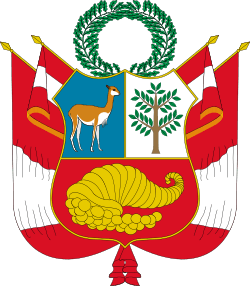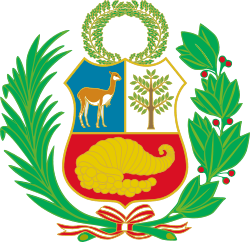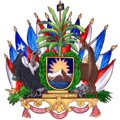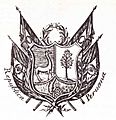Coat of Arms of Peru facts for kids
Quick facts for kids Coat of arms of Peru |
|
|---|---|
 |
|
| Versions | |

The Coat of arms (Escudo de armas) as used in the centered on the white band of the National flag.
|
|
| Armiger | Republic of Peru |
| Adopted | 25 February 1825 |
| Crest | Holm oak civic crown |
| Blazon | Per fess, the first per pale azure and argent in dexter a vicuña counter-statant proper and in sinister a cinchona tree also proper, the second gules, a cornucopia with coins spilling from it. |
| Supporters | Two National Flags of Peru and two standards on each side. |
| Other elements | When used on the National Flag, the Coat of arms (Escudo de armas) is surrounded by a wreath of palm branch one on the left and a laurel one on the right tied by a red and white ribbon. |
The Coat of arms of Peru is a special symbol for the country of Peru. It's like a picture that tells a story about the nation. This important symbol is used in different ways.
There are four main types of the Peruvian Coat of Arms. These include the main Coat of Arms (Escudo de Armas). There is also the National Coat of Arms (Escudo Nacional). The Great Seal of the State (Gran Sello del Estado) is another version. Finally, there is the Naval Coat of Arms (Escudo de la Marina de Guerra).
Contents
What is the Coat of Arms of Peru?
The Coat of Arms of Peru is a design that shows important parts of the country. It was officially adopted on February 25, 1825. The design has a shield, a crown, and flags.
The main part is a shield divided into three sections. Each section holds a symbol that represents something valuable about Peru.
Symbols on the Shield
The shield of the Coat of Arms has three main symbols. These symbols represent the animals, plants, and wealth of Peru.
The Vicuña
In the top left part of the shield, there is a vicuña. A vicuña is an animal that looks like a small llama. It lives in the Andes mountains of Peru. The vicuña represents the rich animal life of the country. It also symbolizes freedom and national pride.
The Cinchona Tree
On the top right side of the shield, you will see a cinchona tree. This tree is very important because its bark was used to make quinine. Quinine was a medicine used to treat malaria. The cinchona tree represents the natural plant resources of Peru. It also symbolizes health and healing.
The Cornucopia
The bottom part of the shield shows a cornucopia. A cornucopia is a horn-shaped basket overflowing with gold and silver coins. This symbol represents the great mineral wealth of Peru. It shows the country's rich mines and resources.
Other Important Parts
Besides the shield, the Coat of Arms has other parts that add to its meaning. These include a crown and flags.
The Civic Crown
Above the shield, there is a Holm oak civic crown. This crown is made of oak leaves. It represents heroism and the brave actions of the Peruvian people. It also symbolizes the country's independence and its republican government.
Flags and Wreath
On each side of the shield, there are two Peruvian national flags and two standards. These flags show the country's pride and sovereignty.
When the Coat of Arms is used on the National Flag, it has an extra detail. It is surrounded by a wreath. This wreath has a palm branch on the left and a laurel branch on the right. These branches are tied together with a red and white ribbon. The palm branch often means victory, and the laurel branch symbolizes honor and glory.
Images for kids
See also
 In Spanish: Escudo del Perú para niños
In Spanish: Escudo del Perú para niños




